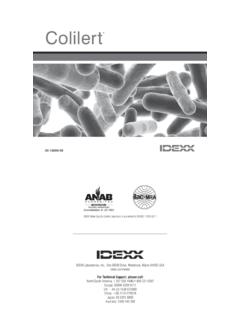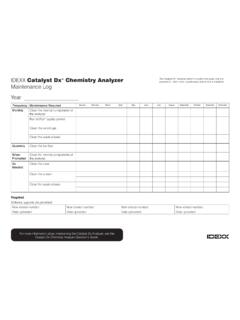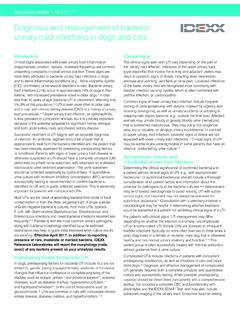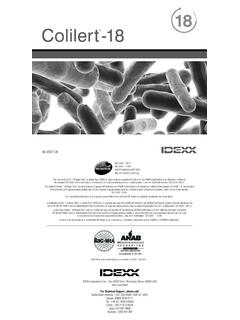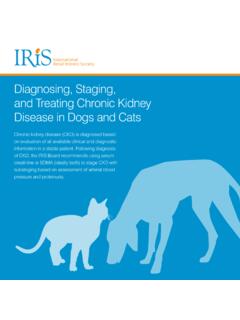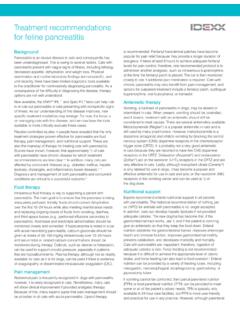Transcription of SNAP 4Dx - IDEXX
1 Screening for vector-borne diseaseSNAP 4Dx Plus Test clinical reference guideEvery dog, every yearThe Companion Animal Parasite Council (CAPC) Guidelines recommend annual comprehensive screening for pathogens transmitted by ticks and Adding an annual cycle of comprehensive testing and year-round prevention to your practice benefits your patients, clients, and practice in 3 important ways: 1. React to changing prevalence Mosquitoes and ticks are constantly on the move, and annual testing is the most reliable way to determine if new infections are threatening pets in your area.
2 Pets move too, of course; without comprehensive testing , you sacrifice the ability to detect and treat mosquito and tick-borne infections acquired in other locations. 2. Detect and treat coinfection Comprehensive testing lets you assess a dog s risk of having more than one Measure the effectiveness of prevention protocols Only comprehensive testing helps you know if your prevention protocols are working. Even a negative result is valuable; it s an opportunity to celebrate the pet owner s role in successfully preventing these infections and keeping their pet healthy.
3 With the SNAP 4Dx Plus Test, a positive result can also be an indication of ticks and other pathogens in your area. Know more with every resultdetect antibodies to these pathogensWhen you use the SNAP 4Dx Plus Test as a screening tool, you maycarried by these ticksAnaplasma phagocytophilumBorrelia burgdorferi (Lyme disease)Ehrlichia ewingiiEhrlichia canisAnaplasma platysBabesia Mountain spotted feverEhrlichia chaffeensisTularemiaRocky Mountain spotted feverSTARIB artonella canisBrown dog tick Rhipicephalus sanguineusAmerican dog tick Dermacentor variabilisDeer tick or black-legged tick Ixodes scapularis Ixodes pacificusLone star tick Amblyomma americanumRocky Mountain spotted feverTularemiaGeographic tick distribution as of 20153that may also transmit other infections to dogs and peopleHeartworm diseaseDirofilaria
4 Immitis, the causative agent of heartworm disease, is transmitted by infected mosquitoes when D. immitis larvae are transferred to a healthy dog. Heartworm disease has no obvious clinical signs in the early stages, making preventive measures so much more important especially as advanced infection may result in death. Confirm with retest* Evaluate for microfilaria CBC/chemistry panel Complete urinalysis Other tests as appropriateInfection unlikelyPositive result Confirm with retest* Evaluate for microfilariaClinical signs DO support heartworm diseaseTreatment depends on supplemental test resultsIf no definitive diagnosis.
5 Repeat diagnostics in 1 3 monthsNo clinical signsHeartworm preventionRetest in 12 months Radiographs CBC/chemistry panel Complete urinalysis Other tests as appropriateAccording to American Heartworm Society (AHS) guidelinesRetest in 6 12 months Assess heartworm antigen status Assess cardiopulmonary diseasePrescribe year-round heartworm prevention as recommended by AHS and CAPC guidelinesWhat to do with your SNAP test resultDid you know? Despite availability of monthly preventives, prevalence rates of canine heartworm have remained consistent The American Heartworm Society (AHS) and the Companion Animal Parasite Council (CAPC) recommend testing all dogs for both antigen and microfilariae at least , 8 For more information and current recommendations on treating canine heartworm disease, go to or Dirofilaria immitisPrimary vector MosquitoPathologyInfective larvae (L3)
6 Mature to adult worms in the heart and pulmonary arteriesClinical presentationAsymptomatic at first, later developing: Mild, persistent cough Lethargy Exercise intolerance Reduced appetiteLaboratory abnormalities Weight loss Eosinophilia Azotemia Increased liver enzymes ProteinuriaMonitorPreventTreatDiagnoseWh at to do next?Lyme diseaseTransmitted by the deer tick or black-legged tick, Lyme disease is caused by the bacterium Borrelia burgdorferi. Clinical signs may not appear until several months after infection.
7 Lyme disease has been found throughout North America with cases ranging from mild to severe. Did you know? Dogs testing positive for antibodies to the C6 peptide had 43% increased risk of having chronic kidney disease compared to seronegative The C6 peptide used in the SNAP 4Dx Plus Test and Lyme Quant C6 Test does not cross-react with the antibody response to commercially available Lyme Dogs with seroreactivity to both B. burgdorferi and Anaplasma phagocytophilum may have two times the risk of developing clinical illness than singularly infected burgdorferiPrimary vectors Ixodes scapularis or Ixodes pacificus (deer tick and black-legged tick)Pathology Localizes in tissues of infected dogs Synovitis (may be subclinical) Lyme nephritisClinical presentationChronic infection with clinical signs that may present acutely.
8 Fever, anorexia Polyarthritis, lameness Rapidly progressive renal failure Neurologic syndromesLaboratory abnormalities Elevated C6 antibody level 30 U/mL Proteinuria IDEXX SDMA Test >14 g/dLWhat to do with your SNAP test resultMonitorTreatDiagnose*What to do next? Review benefits of tick prevention Retest in 1 yearDoxycycline/tetracyclineMonitor for clinical signs; retest C6 antibody level to confirm success of treatment and/or inform re-exposure to infected ticks Perform annual minimum database, including a complete chemistry panel with the IDEXX SDMA Test, CBC, and complete urinalysisNot generally recommendedClinical signs and/or laboratory findings DO NOT support Lyme disease (C6 antibody level <30 U/mL)Clinical signs and/or laboratory findings DO support Lyme disease (C6 antibody level 30 U/mL)
9 Negative result Infection is unlikelyPositive result indicates infection* Serology is typically used to diagnose Lyme disease. B. burgdorferi localizes to the tissues and is therefore rarely detectable in the blood by result*A heartworm antigen test by ELISA at a reference laboratory is recommended as the confirmatory tick prevention strategies and reinforce value of year-round protection Determine C6 antibody level with the Lyme Quant C6 Test Perform minimum database, including: CBC with or without blood film evaluation Complete chemistry panel with the IDEXX SDMA Test to evaluate for kidney disease Complete urinalysis to evaluate for proteinuriaCanine anaplasmosisCanine granulocytic anaplasmosis is caused by the bacterium Anaplasma phagocytophilum (transmitted by the deer tick or black-legged tick).
10 Anaplasma platys (transmitted by the brown dog tick) is the cause of infectious cyclic you know? Many mammalian species, including humans, are susceptible to A. phagocytophilum infection. Dogs coinfected with Anaplasma and other bacterial pathogens may have more complex disease presentations and respond more slowly to therapy. A. platys infects canine platelets and is frequently seen as a coinfection with Ehrlichia canis. Canine ehrlichiosisCanine ehrlichiosis is caused by the bacteria Ehrlichia canis (transmitted by the brown dog tick) and Ehrlichia ewingii (transmitted by the lone star tick).
